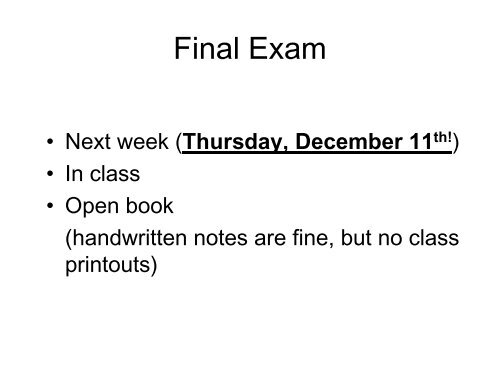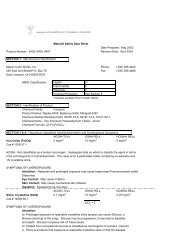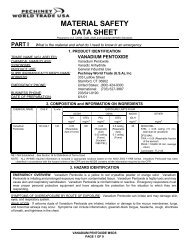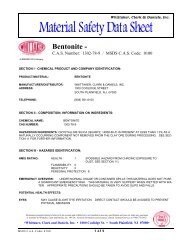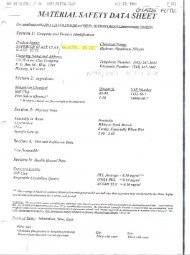Raw Mats Fall 2008 Study Guide - Alfred's Clay Store
Raw Mats Fall 2008 Study Guide - Alfred's Clay Store
Raw Mats Fall 2008 Study Guide - Alfred's Clay Store
Create successful ePaper yourself
Turn your PDF publications into a flip-book with our unique Google optimized e-Paper software.
the problem can be solved in O(n(n − k) d+1 ) time [18, 4].An alternative approach that can also be deployed in thiscase is an algorithm by Har-Peled and Wang for approximateshape fitting with outliers [16], which extracts a smallcoreset and finds the best possible solution within this coreset.However, this algorithm excels only when the number ofoutliers is small; specifically, the running time is near-linearonly if k ≥ n − o(n 1/2d ). The case of most interest to us,where n − k = Ω(n), is the worst case for these algorithms.It is natural to ask whether either of these approaches canbe extended to handle the case where the number of outliersis large.Finally, the problem of fitting the data with two slabsof minimum width seems to be inherently connected to theproblem of LMS; intuitively, we want to find a good clusteringfor most of the points by the first slab, and also agood clustering for the remaining (outlier) points. Thus, abetter understanding of the LMS problem might lead to abetter understanding of the two-slab problem, which seemsto be surprisingly hard [15]. Currently no near-linear-timeapproximation algorithm is known for d > 3. Thus, LMSis a fundamental problem, and a better understanding ofit would lead to a better understanding of several centraloptimization problems.Given the high complexity of computing the LMS estimatorexactly, it is natural to consider whether more efficientapproximation algorithms exist. Mount et al. [20] presenteda practical approximation algorithm for the LMS lineestimator in the plane, based on approximating the quantileand/or the vertical width of the slab. Their algorithm,however, does not guarantee a better than O(n 2 ) runningtime when the quantile is required to be exact. Olson presenteda 2-approximation algorithms for LMS, which runsin O(n log 2 n) time in the plane and in O(n d−1 log n) timefor any fixed d ≥ 3 [21].In this paper we consider the computational complexityof the both the exact and approximate versions of the LMSproblem. In Section 3, we describe a randomized algorithmto compute the exact LMS estimator for n points in IR d inO(n d log n) time with high probability. We also describe, inSection 4, a randomized ε-approximation algorithm whoserunning time is O((n d /kε) polylog) with high probability.For the most interesting case k = Ω(n), this is faster thanour exact algorithm by roughly a factor of n/ε.In Section 5, we provide results suggesting that any exactalgorithm for the LMS problem requires Ω(n d ) time, and anyconstant-factor approximation algorithm requires Ω(n d−1 )time, thus providing a strong indication that our algorithmsare close to optimal. Specifically, we describe linear-timereductions from the affine degeneracy problem: Given a setof n points on the d-dimensional integer 1 lattice Z d , do anyd + 1 of the points lie on a common hyperplane? These reductionsimply lower bounds if the following widely-believedconjecture is true.Conjecture 1.1 Solving the d-dimensional affine degeneracyproblem requires Ω(n d ) time in the worst case.If this conjecture is true, the Ω(n d ) lower bound is tight;the problem can be solved in O(n d ) time by constructing1 In the algebraic decision tree model of computation, the restrictionto integers can be removed by using formal infinitesimals inour reductions [10, 11].the dual hyperplane arrangement. Erickson and Seidel [13,12] proved an Ω(n d ) lower bound on the number of sidednessqueries required to solve this problem; however, the model ofcomputation in which their lower bound holds is not strongenough to solve the LMS problem, since it does not allowus to compare widths of different slabs. The strongestlower bound known in any general model of computation isΩ(n log n), for any fixed dimension, in the algebraic decisionand computation tree models [2, 25], although the problemis known to be NP-complete when d is not fixed [17,12]. The planar affine degeneracy problem is one of Gajentaanand Overmars’ canonical 3sum-hard problems [14]. (Inhigher dimensions, the affine degeneracy problem is actually(d + 1)-sum-hard [12]; however, the best lower bound thatthis could imply is only Ω(n ⌊d/2⌋+1 ) [11].)2. NOTATION AND TERMINOLOGYWhenever we work in the space IR d , we will refer to thex d -coordinate direction as vertical and each of the other coordinatedirections as horizontal. A hyperplane is vertical ifit contains a vertical line and horizontal if its normal directionis vertical.A slab is the non-empty intersection of two closed halfspaceswhose bounding hyperplanes are parallel. We will distinguishbetween two different natural notions of the “thickness”of a slab. The height of a slab σ, denoted ht(σ), is thelength of a vertical line segment with one endpoint on eachbounding hyperplane. If one slab has smaller height thananother, we say that the first slab is shorter and the secondis taller. We denote by ht(P, k) the height of the shortestslab containing at least k points from a point set P. Onthe other hand, the width of a slab σ, denoted wd(σ), isthe distance between the two bounding hyperplanes, measuredalong their common normal direction. If one slab hassmaller width than another, we say that the first slab is narrowerand the second is wider. We denote by wd(P, k) thewidth of the narrowest slab containing at least k points in apoint set P. A slab whose height or width is zero is just ahyperplane. Vertical slabs, even those with zero width, haveinfinite height.The LMS problem has a natural dual formulation, whichis crucial in the development of our algorithms. We usethe standard duality transformation that maps any point(a 1, a 2, . . . , a d ) to the hyperplane x d = a 1x 1 + a 2x 2 + · · · +a d−1 x d−1 − x d and vice versa. Under this duality map, apoint p is above (resp. below) a hyperplane h if and onlyif the dual hyperplane p ∗ is below (resp. above) the dualpoint h ∗ ; moreover, the vertical distance between the pointand the hyperplane is preserved. The dual of a slab σ is avertical line segment σ ∗ of length ht(σ); a point p lies insidethe slab σ if and only if the dual hyperplane p ∗ intersects thedual segment σ ∗ . Thus, the LMS problem is equivalent tofinding, given a set H of hyperplanes, the shortest verticalsegment that intersects at least k of them. To be consistentwith the primal formulation, we let ht(H,k) denote thelength of this segment.For any hyperplane h and any real value t, let h + t denotethe hyperplane resulting from translating h upward by(vertical) distance t, and let σ(h, t) denote the slab boundedby h and h + t.274


